Abstract
1. Unitary synaptic potentials evoked by the activity of single vestibulocollic neurones were recorded by means of spike-triggered signal averaging in neck extensor motoneurones of decerebrate cats. Properties of the vestibulocollic neurones which produced the potentials were examined.
2. Vestibulocollic neurones were first identified as projecting to the C3 grey matter by antidromic microstimulation within the C3 extensor motoneurone pool. The spontaneous or glutamate-driven activity of the vestibulocollic neurones was then used to trigger the averaging computer. In this way ten inhibitory and two excitatory neurones were identified (20% of neurones tested).
3. Action potentials in local branches of vestibulocollic neurones were usually recorded in the vicinity of motoneurones. Mean orthodromic conduction time from the foot of the extracellular spike, recorded in the vestibular nuclei, that triggered the averager was 0·72 msec. Mean synaptic delay was 0·4 msec.
4. I.p.s.p.s had a mean time to peak of 0·81 msec and were readily reversed by injection of hyperpolarizing current. These data, together with the shape indices of i.p.s.p.s indicate that they are generated proximally on motoneurones.
5. All vestibulocollic neurones making synapses with motoneurones were monosynaptically driven by stimulation of the ipsilateral vestibular nerve. Four out of seven tested were inhibited by stimulation of the contralateral vestibular nerve (commissural inhibition).
6. Two excitatory neurones were located in Deiters' nucleus or on the Deiters'-descending border. Inhibitory neurones were found relatively medially in the vestibular complex in the medial, descending and Deiters' nuclei.
7. Vestibulocollic neurones acting on motoneurones were tested for axon branching to more caudal levels of the spinal cord with electrodes placed at C5-7. Both of the excitatory and two out of nine inhibitory neurones branched.
Full text
PDF


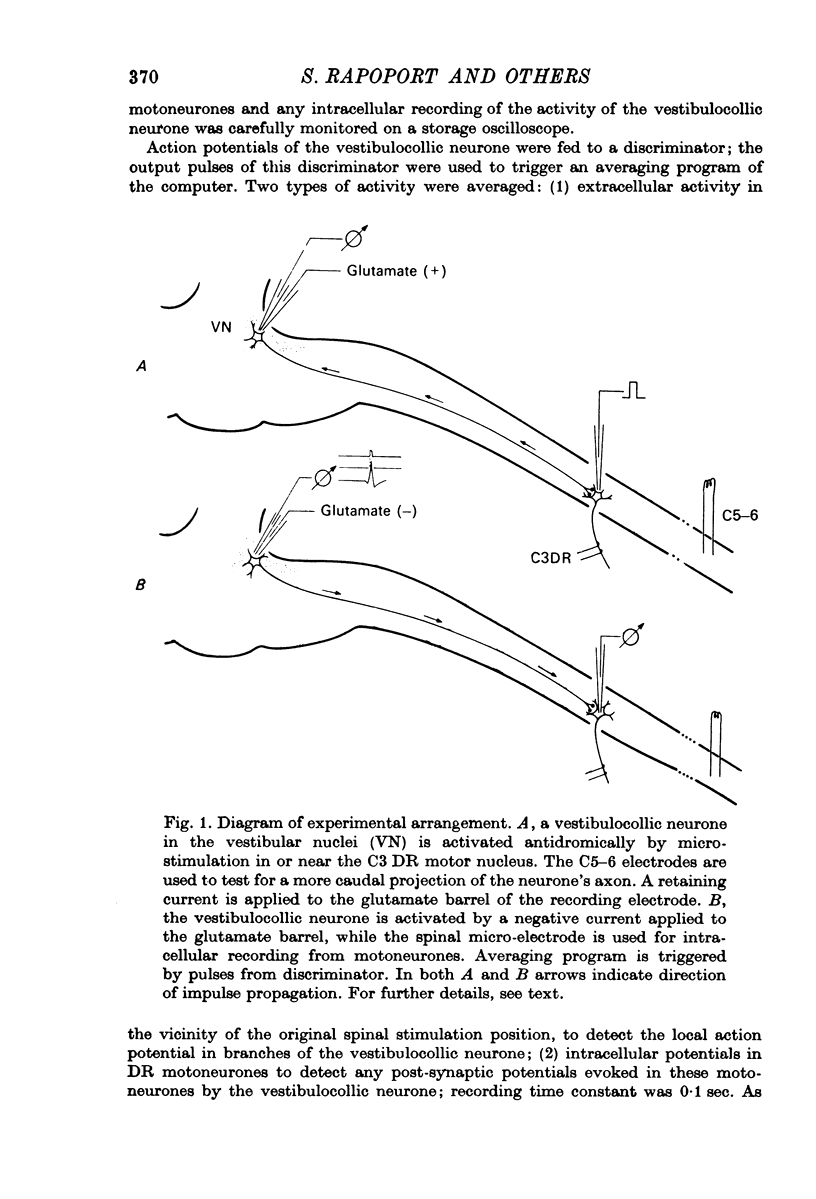



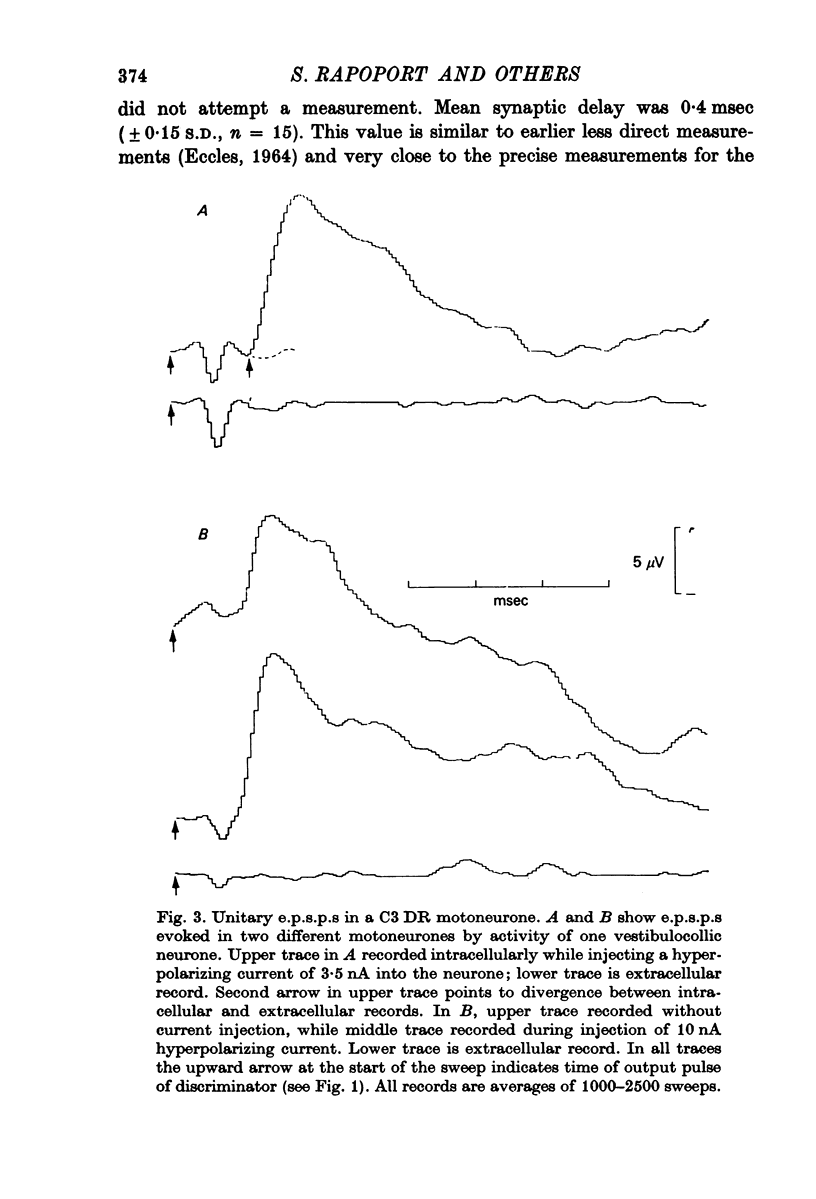


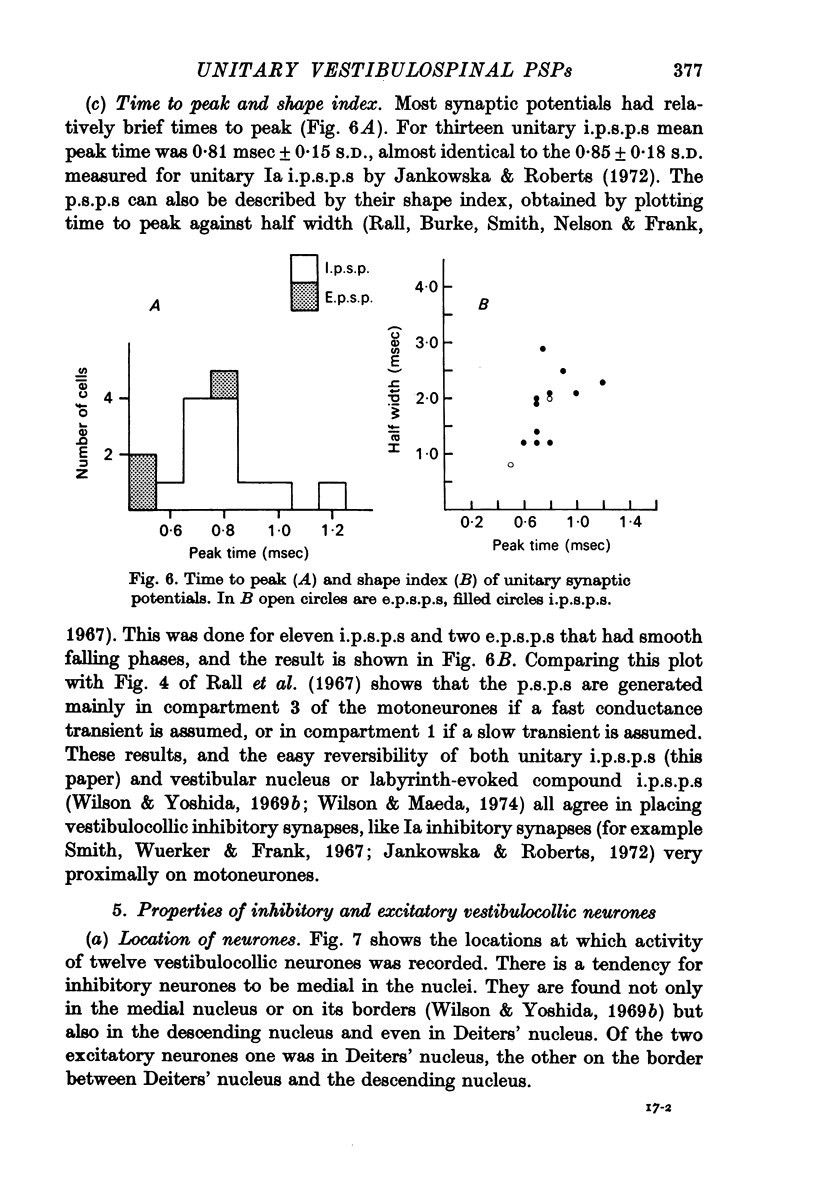

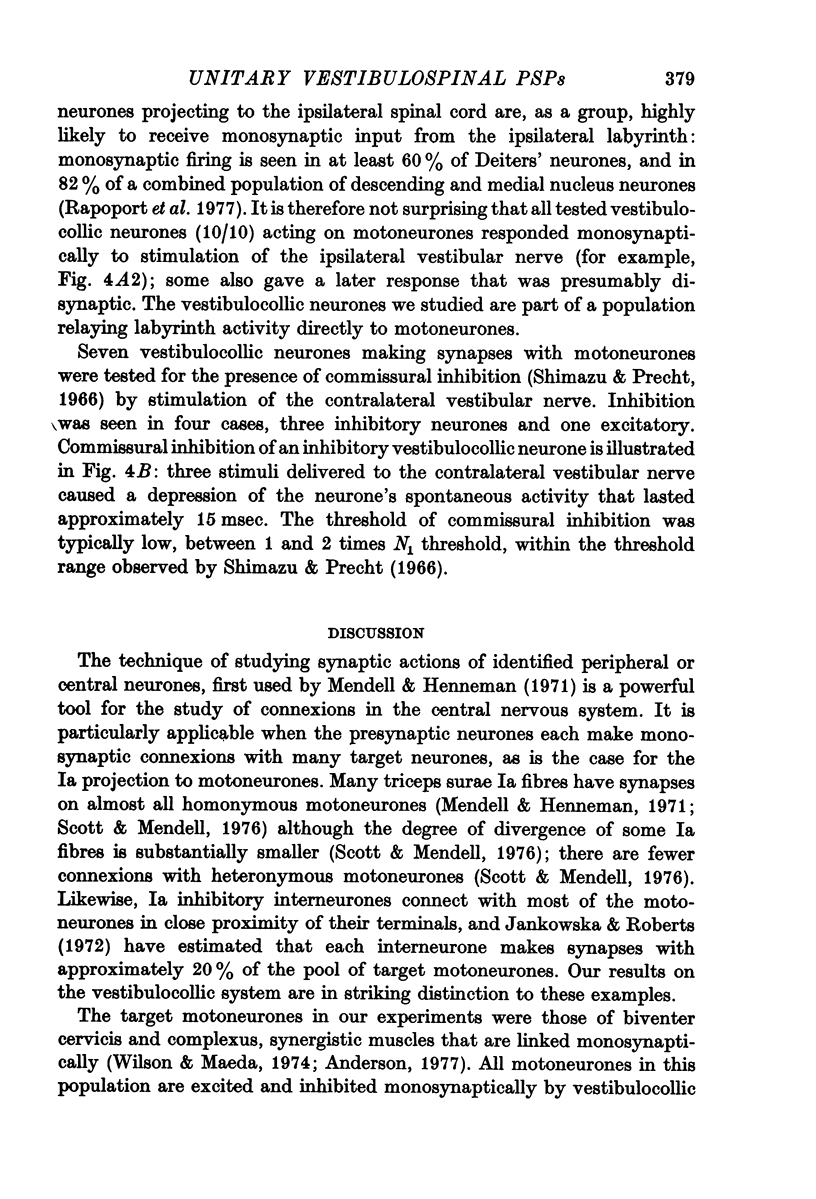


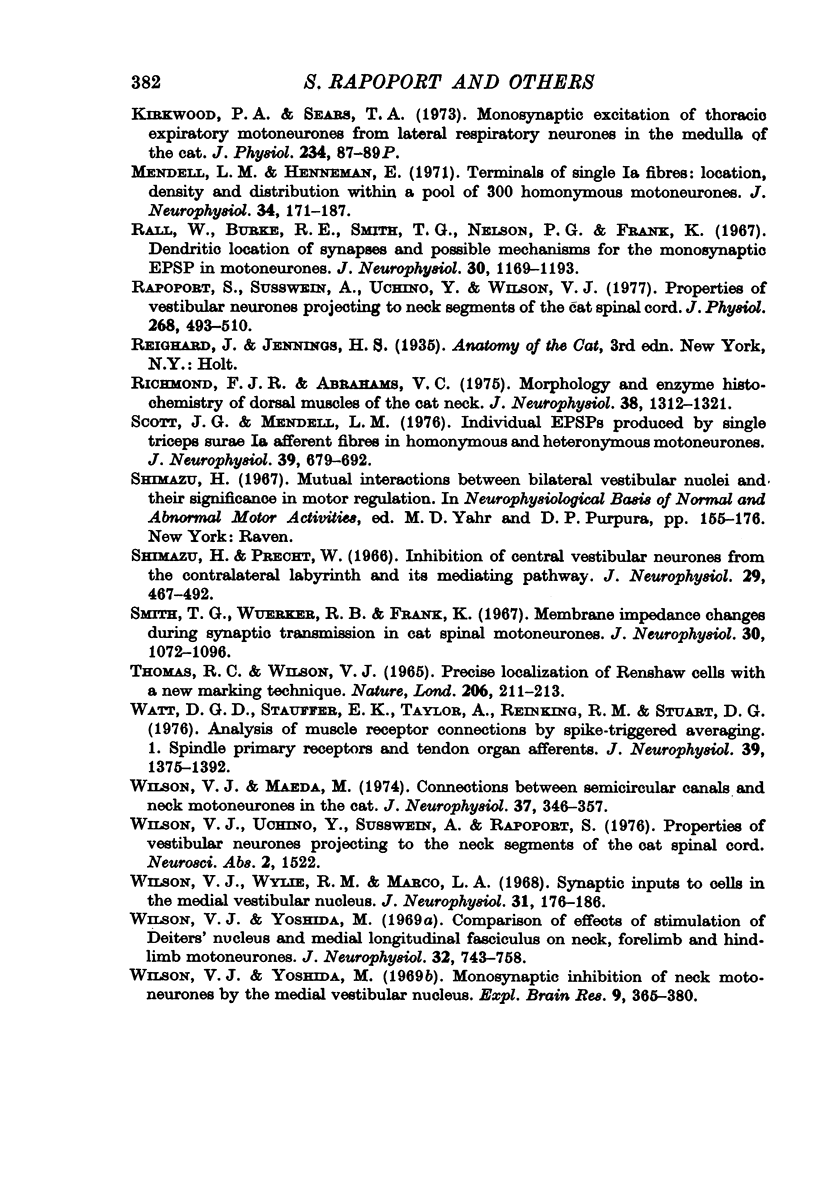
Selected References
These references are in PubMed. This may not be the complete list of references from this article.
- Akaike T., Fanardjian V. V., Ito M., Kumada M., Nakajima H. Electrophysiological analysis of the vestibulospinal reflex pathway of rabbit. I. Classification of tract cells. Exp Brain Res. 1973 Jul 30;17(5):477–496. doi: 10.1007/BF00234863. [DOI] [PubMed] [Google Scholar]
- Akaike T., Fanardjian V. V., Ito M., Ono T. Electrophysiological analysis of the vestibulospinal reflex pathway of rabbit. II. Synaptic actions upon spinal neurones. Exp Brain Res. 1973 Jul 30;17(5):497–515. doi: 10.1007/BF00234864. [DOI] [PubMed] [Google Scholar]
- ITO M., HONGO T., YOSHIDA M., OKADA Y., OBATA K. ANTIDROMIC AND TRANS-SYNAPTIC ACTIVATION OF DEITERS' NEURONES INDUCED FROM THE SPINAL CORD. Jpn J Physiol. 1964 Dec 15;14:638–658. doi: 10.2170/jjphysiol.14.638. [DOI] [PubMed] [Google Scholar]
- Jankowska E., Roberts W. J. Synaptic actions of single interneurones mediating reciprocal Ia inhibition of motoneurones. J Physiol. 1972 May;222(3):623–642. doi: 10.1113/jphysiol.1972.sp009818. [DOI] [PMC free article] [PubMed] [Google Scholar]
- Kirkwood P. A., Sears T. A. Proceedings: Monosynaptic excitation of thoracic expiratory motoneurones from lateral respiratory neurones in the medulla of the cat. J Physiol. 1973 Oct;234(2):87P–89P. [PubMed] [Google Scholar]
- Mendell L. M., Henneman E. Terminals of single Ia fibers: location, density, and distribution within a pool of 300 homonymous motoneurons. J Neurophysiol. 1971 Jan;34(1):171–187. doi: 10.1152/jn.1971.34.1.171. [DOI] [PubMed] [Google Scholar]
- Rall W., Burke R. E., Smith T. G., Nelson P. G., Frank K. Dendritic location of synapses and possible mechanisms for the monosynaptic EPSP in motoneurons. J Neurophysiol. 1967 Sep;30(5):1169–1193. doi: 10.1152/jn.1967.30.5.1169. [DOI] [PubMed] [Google Scholar]
- Rapoport S., Susswein A., Uchino Y., Wilson V. J. Properties of vestibular neurones projecting to neck segments of the cat spinal cord. J Physiol. 1977 Jun;268(2):493–510. doi: 10.1113/jphysiol.1977.sp011868. [DOI] [PMC free article] [PubMed] [Google Scholar]
- Scott J. G., Mendell L. M. Individual EPSPs produced by single triceps surae Ia afferent fibers in homonymous and heteronymous motoneurons. J Neurophysiol. 1976 Jul;39(4):679–692. doi: 10.1152/jn.1976.39.4.679. [DOI] [PubMed] [Google Scholar]
- Thomas R. C., Wilson V. J. Precise localization of Renshaw cells with a new marking technique. Nature. 1965 Apr 10;206(980):211–213. doi: 10.1038/206211b0. [DOI] [PubMed] [Google Scholar]
- Watt D. G., Stauffer E. K., Taylor A., Reinking R. M., Stuart D. G. Analysis of muscle receptor connections by spike-triggered averaging. 1. Spindle primary and tendon organ afferents. J Neurophysiol. 1976 Nov;39(6):1375–1392. doi: 10.1152/jn.1976.39.6.1375. [DOI] [PubMed] [Google Scholar]
- Wilson V. J., Maeda M. Connections between semicircular canals and neck motorneurons in the cat. J Neurophysiol. 1974 Mar;37(2):346–357. doi: 10.1152/jn.1974.37.2.346. [DOI] [PubMed] [Google Scholar]
- Wilson V. J., Wylie R. M., Marco L. A. Synaptic inputs to cells in the medial vestibular nucleus. J Neurophysiol. 1968 Mar;31(2):176–185. doi: 10.1152/jn.1968.31.2.176. [DOI] [PubMed] [Google Scholar]
- Wilson V. J., Yoshida M. Comparison of effects of stimulation of Deiters' nucleus and medial longitudinal fasciculus on neck, forelimb, and hindlimb motoneurons. J Neurophysiol. 1969 Sep;32(5):743–758. doi: 10.1152/jn.1969.32.5.743. [DOI] [PubMed] [Google Scholar]


